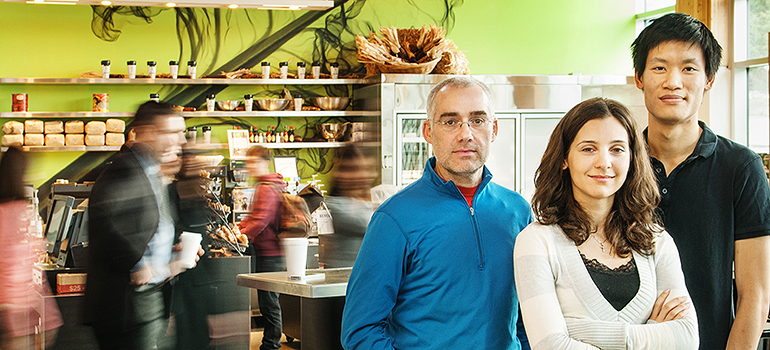It’s not easy being green but a UBC study shows the right building design is key.
Most people don’t need to be told to “shush” in a library: the studious ambience promotes quiet behaviour.
In the same way, UBC researchers have found a significant connection between occupying a green building and behaving in a more environmentally friendly manner. The implications could be momentous for sustainability.
“There’s a potential that you can ‘design in’ environmental conscientiousness,” says Alan Kingstone, who heads UBC’s Department of Psychology. “A green atmosphere promotes more green behaviour. It’s almost like it’s in the air.”
Most students didn’t even know this was a super-green building. Yet when they were in the building they behaved more sustainably.
Kingstone is the senior investigator of a study published in the PLOS ONE journal. His team examined food-disposal behaviour in the café at UBC’s Centre for Interactive Research on Sustainability (CIRS) compared to that at the Student Union Building (SUB).
The two buildings are very different from one another. The SUB is a traditional concrete building in the style of its 1960s generation. CIRS is one of the leading regenerative buildings in North America, opened in 2011. Integrated systems were designed to meet goals of zero carbon emissions, water self-sufficiency, net-positive energy performance, and zero waste.
CIRS was also designed with the intent of creating behavioural change. In the café, no bottled drinks are available for purchase and all utensils are compostable.
“It’s a building that has a lot of light, a lot of wood, and it feels clean and fresh and sustainable,” Kingstone notes.
Despite the structural differences, the eating areas in both buildings have the same disposal options for compostable and recyclable materials. Yet researchers who observed food disposal behaviour found that patrons of the CIRS café were substantially more conscientious about recycling properly. The accuracy rate was 86 per cent at CIRS versus 58 per cent at the SUB.
Both buildings are used by a broad range of students, and the CIRS building does not host a disproportionate number of environmentally-focused classes. Researchers conducted a patron questionnaire to ensure the results didn’t reflect a sampling bias. “Most students didn’t even know this was a super-green building,” Kingstone says, “yet when they were in the building they behaved more sustainably.”
According to Kingstone, location and situation influence our behaviour. But this study shows that people don’t even need to know the intent behind the building (i.e. libraries are for reading) to adjust their behaviour.
“It’s a cultural thing. You pick up the cues very subtly without even thinking about it,” he explains. “If you’re in an environment that reflects a sustainable way of being, then you yourself will behave in a way that’s more sustainable. You start to go with the flow.”
The implication? As a society, we can create a more environmentally responsible culture without explicitly telling people to change their behaviour.
“It seems like design is a useful tool to create a culture in which sustainability is valued,” says David Wu, the study’s lead researcher. From a policy-making perspective, “it definitely adds to the cost-benefit analysis of putting in more green buildings.”
It can also help create a community that reinforces beneficial practices. For example, designing the garbage area of an apartment complex to have an open, sustainable feel where an individual’s actions may be observed by neighbours could promote more conscientious behaviour.
For more on CIRS, see cirs.ubc.ca
The full study can be read at cirs.ubc.ca/publications

